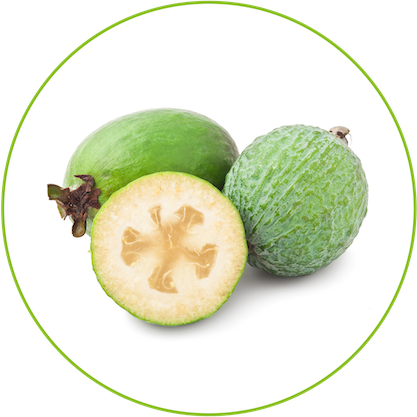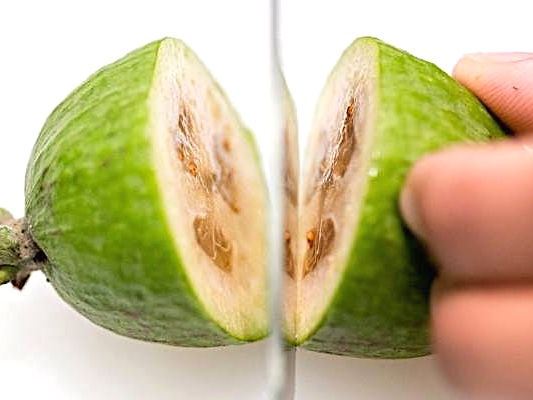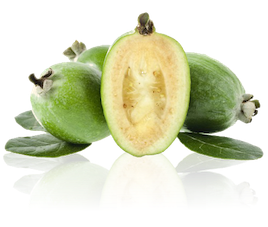Facts
The Fruit

- The fruit of a Feijoa has some very unique characteristics. First of all the Feijoa has a perfumed scent that can be described as sweet, soft and feminine yet medicine like with bubblegum tones and a hint of strawberry and pineapple.
- The shape is round to oval. The majority of the fruit is around 80-120 grams however some varieties and special conditions can produce fruit with a weight over 300g in size.
- Feijoas have a light to dark green skin. The skin is edible, however some people think the skin and flavour can be quite bitter to some palettes.
- In the centre of the fruit there is a very sweet jelly centre with seeds so small and soft you can hardly notice them.
- Surrounding the jelly is another texture again which consists of a pear flesh like which is also quite soft yet somewhat gritty.
Uses

- The fruit is mainly eaten fresh however due to the short season sometime around autumn, Feijoas are often used in cooking and are preserved.
- It’s not only the Feijoa fruit that’s edible! You can also eat the flowers petals! With a sweet and musky taste, they make a great addition to salads.
- Originally the native tribes of South America used the leaves of the Feijoa to make a liquid potion for medicinal purposes. Today in parts of Eastern Europe, The Caucasus and other parts of the ex Soviet Union Feijoa leaves are brewed as tea.
- Chickens have been witnessed eating the Feijoa bark off a tree but not to a point of ring barking, It looks more for nutrition. More yet to be discovered.
Origin and Natural Habitat

- The Feijoa is found growing naturally in South America in an area that borders Uruguay, Brazil, Argentina and Paraguay.
- The region is temperate to sub-tropical. Its has a medium to high rainfall, altitude up to approximately 1000m high. Soils are not very fertile.
- In its natural habitat it grows in a clump with other Feijoa plants. The plants grow very spindly yet dense in a unit. In Uruguay today, you can see Feijoas growing in the wild. They have also grown next to old train tracks, most likely from people eating them and throwing them out the window.
- You can find one of the oldest largest Feijoa trees near Punta del Este, Uruguay at the Arboretum Y Museo “Antonio D. Lussich” .
- Around the middle of the 19th century, Feijoas were first recorded as being collected in a small town in southern Brazil.
Naming

- A German botanist by the name of Otto Berg named it ‘Feijoa Sellowiana’ after the director of the museum of natural history in Pelotas ‘Joam da Silva Feijoa’. Interestingly nearly 100 years later another botanist discovered that Feijoa owned to another genus, so the scientific name was updated to Acca Sellowiana. Although there are many similar aspects found in the Feijoa plant in other specimens such as the olive leaf and the guava fruit it only has three other related species in its genus.
Commercialisation
- It is recorded that in 1890 a botanist by the name of Edouard Andre brought most likely the first samples back to his country of origin in France where the cultivars were improved and distributed to other parts of the world from there. The Feijoa plant was also grown as an ornamental in gardens.
- Today New Zealand is by far the leader in Feijoas. Since the early 20th century New Zealand has been developing new and improved varieties of Feijoas, many that are now grown commercially worldwide. New Zealand is also the largest producer of Feijoas which is estimated to be more than 800 tonnes per year.
- Other countries that are known to grow Feijoas commercially are the USA (mainly California), Colombia, Chile, Brazil, Uruguay, France, Italy, Russia, Georgia, Azerbaijan, Armenia, Turkey, Israel, Australia, Japan and China.

